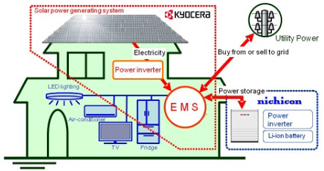Japanese Cleantech Launch Integrated Solar PV-Energy Storage & Management System
 Kyocera and Nichicon are readying the launch of a cleantech residential energy management system that brings together renewable energy electricity production, energy storage and management. The new clean energy management system (EMS) consists of Kyocera solar photovoltaic (PV) panels; Nichicon’s long-life, high-capacity lithium ion battery storage/electric vehicle (EV) charging units; a DC-AC power inverter; and a sophisticated energy efficiency management software system that integrates it all.
Kyocera and Nichicon are readying the launch of a cleantech residential energy management system that brings together renewable energy electricity production, energy storage and management. The new clean energy management system (EMS) consists of Kyocera solar photovoltaic (PV) panels; Nichicon’s long-life, high-capacity lithium ion battery storage/electric vehicle (EV) charging units; a DC-AC power inverter; and a sophisticated energy efficiency management software system that integrates it all.With Japanese demand for independent, grid-tied, and off-grid power systems growing, the partners are readying for a summer launch. The integrated residential solar EMS makes use of Samsung SDI lithium ion batteries.
“This new system combines the two vital themes of power generation and power storage using Kyocera’s solar power generating system and Nichicon’s energy storage unit,” explained Kyocera President Tetsuo Kuba at a joint press conference with Nichicon held in Kyoto, January 16. “Kyocera will use its energy-management technology to launch this new comprehensive system for optimizing residential energy use, and thus make a real contribution to preventing climate change.”
According to a joint press release, features of the solar PV EMS include:
Long-lasting, high-volume lithium-ion battery
The system uses a lithium-ion battery, which can last roughly 5 times longer than conventional lead-acid batteries. The battery has a high capacity of 7.1kWh, weighs roughly 200kg and has a size of 120H x 90W x 35D (centimeters).
Various EMS modes to fit energy use patterns and needs
The new system offers various operating modes to meet the energy use patterns and needs of various customers — whether their peak energy consumption occurs in the daytime or at night; and for families who want to prioritize reducing their energy bill or those who place a premium on guaranteed electricity supply.
System automatically switches to independent operation in the event of a natural disaster or electricity black-out
In the event of a prolonged black-out, the battery can be charged directly by the solar modules during the day, allowing users to draw from the battery at night or during inclement weather.
Costs weren’t disclosed, but the partners have high hopes for the system. “We’d like to see use of this system — that combines Kyocera’s top-class solar power generating systems, Nichicon’s energy storage units which hold top domestic share for EV charging systems, and Samsung SDI’s lithium-ion batteries which hold the largest global share — sweep the Japanese market,” Nichicon Chairman & CEO Ippei Takeda stated.
You can return to the main Market News page, or press the Back button on your browser.

